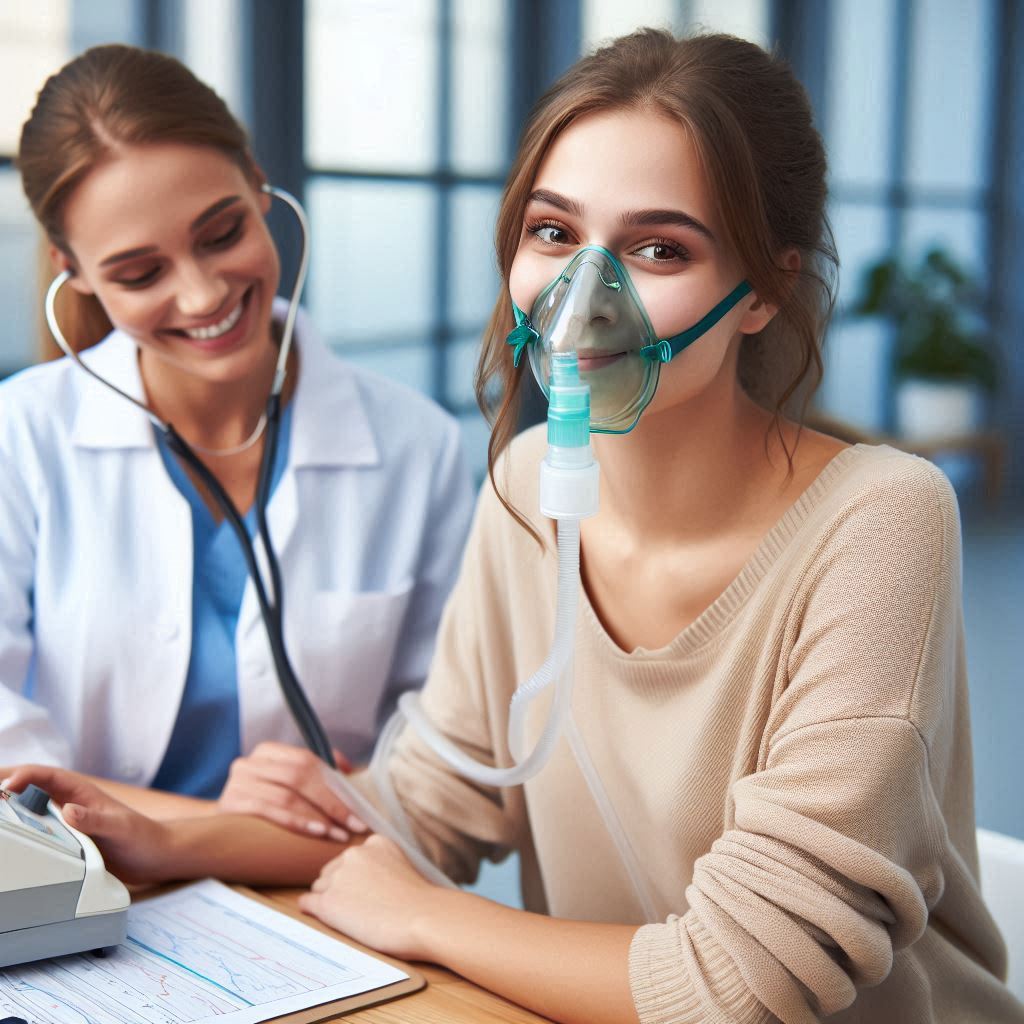Introduction
Respiratory therapy focuses on diagnosing, treating, and managing patients with breathing disorders.
This field has evolved significantly over the years, becoming a critical component of modern healthcare.
Respiratory therapists work with patients suffering from chronic conditions like asthma, COPD, and acute respiratory issues such as those caused by infections or trauma.
Their goal is to improve patients’ breathing, enhance their quality of life, and sometimes save lives.
Technological advances play a crucial role in enhancing respiratory care.
Innovations in medical technology have transformed how respiratory therapists diagnose and treat patients.
These advances include everything from sophisticated ventilators and portable oxygen concentrators to advanced monitoring systems and telehealth solutions.
Each innovation helps improve patient outcomes, making respiratory therapy more effective and efficient.
These technologies not only improve patient care but also streamline the work of respiratory therapists.
For instance, advanced ventilators offer more precise control over breathing support, reducing the risk of complications and improving patient comfort.
Portable oxygen concentrators allow patients to maintain mobility and independence while receiving necessary oxygen therapy.
Monitoring systems provide real-time data, enabling timely interventions and better management of respiratory conditions.
Historical overview of respiratory therapy
Brief history of respiratory therapy as a profession
Respiratory therapy as a profession has a relatively short history compared to other medical disciplines. It emerged in the mid-20th century in response to the growing need for specialized care for patients with respiratory disorders.
Initially, respiratory therapy was primarily focused on delivering oxygen to patients with breathing difficulties.
Over time, the role of respiratory therapists expanded to include a wide range of services such as administering medications, managing ventilators, and providing pulmonary rehabilitation.
The profession of respiratory therapy gained recognition and formal training programs were established to educate respiratory therapists on the complexities of lung function and respiratory care.
Today, respiratory therapists play a crucial role in the healthcare system, working alongside physicians and other healthcare professionals to treat patients with respiratory conditions.
Evolution of technologies used in respiratory therapy
Advances in technology have revolutionized the field of respiratory therapy, enabling therapists to provide more precise and personalized care to patients. The following are some of the key technological innovations that have significantly impacted respiratory therapy
Ventilators
Mechanical ventilators are essential devices used to support patients who are unable to breathe on their own. Modern ventilators are equipped with advanced features such as pressure control, volume control, and sophisticated alarms to ensure optimal patient care.
Pulse oximeters
These devices are used to measure the oxygen saturation levels in a patient’s blood. Pulse oximeters provide a quick and non-invasive way to monitor a patient’s respiratory status and adjust oxygen therapy accordingly.
Nebulizers
Nebulizers are devices that convert liquid medication into a fine mist that can be inhaled directly into the lungs. They are commonly used to deliver bronchodilators and other medications to treat respiratory conditions such as asthma and chronic obstructive pulmonary disease (COPD).
Pulmonary function testing equipment
Pulmonary function tests are essential in diagnosing and monitoring respiratory disorders.
Modern pulmonary function testing equipment, such as spirometers and plethysmographs, provide accurate measurements of lung function and help therapists evaluate the effectiveness of treatment interventions.
Continuous positive airway pressure (CPAP) machines
CPAP machines are used to treat sleep apnea and other breathing disorders by delivering a continuous flow of air to keep the airways open during sleep. These devices have become smaller, quieter, and more user-friendly over the years, improving patient compliance and comfort.
Overall, technological advances in respiratory therapy have transformed the way respiratory care is delivered, leading to improved patient outcomes and quality of life for individuals with respiratory conditions.
Read: How Genetic Counseling Improves Patient Care
Current technological advances in respiratory therapy
Non-Invasive Ventilation Techniques
Non-invasive ventilation (NIV) techniques have revolutionized respiratory therapy by providing a less intrusive method of delivering respiratory support to patients.
NIV involves the use of a mask or similar device to deliver air or oxygen to the lungs without the need for intubation.
One common form of NIV is continuous positive airway pressure (CPAP), often used to treat sleep apnea and acute respiratory distress syndrome.
Transform Your Career Today
Unlock a personalized career strategy that drives real results. Get tailored advice and a roadmap designed just for you.
Start NowAnother form of NIV is bilevel positive airway pressure (BiPAP), which provides two levels of pressure to assist with breathing.
NIV can help prevent the need for invasive mechanical ventilation and reduce the risk of complications associated with intubation.
High-Flow Oxygen Therapy
High-flow oxygen therapy is a technique that delivers a high flow of heated and humidified oxygen to patients through a nasal cannula.
This method can provide oxygen at rates of up to 60 liters per minute, exceeding the traditional limit of 15 liters per minute with standard oxygen therapy.
High-flow oxygen therapy is beneficial for patients with respiratory distress, as it can improve oxygenation, reduce work of breathing, and decrease the need for intubation.
It also helps to wash out carbon dioxide from the upper airways, making it easier for the patient to breathe and improving overall comfort.
High-flow oxygen therapy has been shown to improve outcomes in patients with acute respiratory failure and can be used in both hospital and home settings.
Portable Oxygen Concentrators
Portable oxygen concentrators are lightweight devices that concentrate oxygen from the surrounding air and deliver it to the patient through a nasal cannula or mask.
These devices are battery-powered and do not require refills like traditional oxygen tanks, making them convenient for travel and daily use.
Portable oxygen concentrators offer patients quieter and more discreet oxygen delivery, enabling them to maintain independence and mobility.
Portable oxygen concentrators vary in size and configuration to meet the needs of different patients, including low-flow and high-concentration requirements.
Overall, portable oxygen concentrators have revolutionized the way oxygen therapy is delivered, providing freedom and flexibility to patients with respiratory conditions.
Technological advances in respiratory therapy, like non-invasive ventilation and portable oxygen concentrators, enhance patient care significantly.
Read: Genetic Counseling for Inherited Disorders
Transform Your LinkedIn into a Job Magnet
Picture recruiters reaching out to you daily. We craft personalized LinkedIn profiles that stand out, boosting your visibility in ways others can't. Elevate your career now.
Upgrade NowRole of telemedicine in respiratory therapy
Telemedicine has significantly reshaped the landscape of respiratory therapy, particularly in how care is delivered and managed. This section explores three key aspects.
How telemedicine has changed the delivery of care, the benefits of remote monitoring for respiratory patients, and examples of telemedicine tools used in respiratory therapy.
Explanation of How Telemedicine Has Changed the Delivery of Care
Telemedicine enables respiratory therapists to provide care remotely, transcending traditional barriers of distance and access.
This capability is especially beneficial for patients in rural or underserved areas who may have limited access to specialized healthcare facilities.
Therapists use telemedicine for virtual consultations, monitoring patients’ conditions, and intervening promptly without requiring long-distance travel.
Telemedicine also facilitates collaboration among healthcare professionals. Specialists can review patient cases remotely, provide consultations, and offer guidance to local healthcare providers.
This collaboration ensures that patients receive comprehensive and coordinated care, regardless of their location.
Benefits of Remote Monitoring for Respiratory Patients
Remote monitoring plays a crucial role in respiratory therapy by allowing continuous tracking of patients’ vital signs and health metrics outside of clinical settings.
This real-time data empowers therapists to monitor disease progression, assess treatment effectiveness, and make informed decisions promptly.
For instance, wearable devices such as pulse oximeters, spirometers, and sleep apnea monitors transmit data to healthcare providers instantly.
The benefits of remote monitoring extend to improving patient compliance and outcomes. Patients can receive personalized feedback and guidance based on their data, enhancing their understanding of their condition and treatment plan.
Early detection of changes or exacerbations allows therapists to intervene proactively, potentially reducing hospitalizations and emergency room visits.
Examples of Telemedicine Tools Used in Respiratory Therapy
Telemedicine tools encompass a variety of technologies designed to enhance care delivery and patient management. These include
Video Consultations
Virtual visits enable face-to-face interactions between therapists and patients, facilitating regular check-ups, symptom management, and education sessions remotely.
Remote Monitoring Devices
Wearable sensors and home monitoring devices collect and transmit physiological data, such as oxygen levels, lung function, and sleep patterns. This data enables therapists to monitor trends over time and adjust treatment plans accordingly.
Mobile Apps and Telehealth Platforms
Applications designed for respiratory therapy allow patients to track symptoms, medication adherence, and lifestyle factors. These platforms also support communication between patients and healthcare providers, fostering continuous engagement and support.
Data Analytics and AI
Advanced analytics tools analyze large datasets from remote monitoring devices, providing insights into patient trends and predicting potential health risks.
Artificial intelligence algorithms can assist in diagnosing conditions and personalizing treatment plans based on individual patient data.
Overall, telemedicine enhances access to care, improves efficiency in managing respiratory conditions, and promotes patient engagement and empowerment.
Respiratory therapists can enhance care by adopting these technologies, leading to better patient outcomes and quality of life.
Telemedicine’s evolution promises to advance healthcare delivery and patient-centered care strategies in respiratory therapy.
Read: How Genetic Counselors Help with Rare Diseases

Impact of artificial intelligence in respiratory therapy
Artificial intelligence (AI) has made significant strides in the field of respiratory therapy, revolutionizing the way we diagnose and treat respiratory conditions.
Overview of AI algorithms used for diagnosis and treatment planning
- AI algorithms analyze medical imaging scans to detect abnormalities in the lungs, allowing for early detection of respiratory diseases.
- These algorithms can also analyze patient data, such as medical history and symptoms, to create personalized treatment plans for individuals with respiratory conditions.
- AI technology enables healthcare providers to make more accurate and timely diagnoses, leading to improved patient outcomes and quality of care.
Wearable devices that use AI to monitor respiratory function
- Wearable devices equipped with AI technology can continuously monitor a patient’s respiratory function in real-time, providing valuable data to healthcare providers.
- These devices can track metrics such as breathing rate, oxygen saturation levels, and lung function, alerting users to any abnormalities or changes in their respiratory health.
- By leveraging AI algorithms, wearable devices can provide early warnings of respiratory distress or exacerbations, allowing for timely intervention and prevention of complications.
Potential future advancements in AI for respiratory therapy
- As AI technology continues to evolve, we can expect further advancements in respiratory therapy, including the development of more sophisticated algorithms for diagnosis and treatment planning.
- AI-driven virtual assistants could assist healthcare providers in managing respiratory conditions, offering insights and recommendations based on real-time data and analysis.
- The integration of AI with other technologies, such as telemedicine and remote monitoring systems, could enhance the delivery of respiratory care, particularly for patients in remote or underserved areas.
Therefore, artificial intelligence is poised to play a crucial role in the future of respiratory therapy, offering innovative solutions for diagnosing, monitoring, and treating respiratory conditions.
By harnessing the power of AI technology, healthcare providers can improve outcomes, enhance patient care, and ultimately save lives.
Craft a Resume That Tells Your Story
At American Profession Guide, we craft resumes and cover letters that tell your unique professional story. Stand out with documents tailored to your industry and showcase your strengths to land your dream job.
Email UsRead: Genetic Testing and Counseling: An Overview
Challenges and Ethics of Implementing New Technologies
When it comes to implementing new technologies in respiratory therapy, there are several challenges and ethical considerations that need to be taken into account. These challenges include
Addressing Concerns about Data Privacy and Security
- Data privacy is a major concern when it comes to using technology in healthcare.
- Patient data must be protected to ensure confidentiality and compliance with regulations.
- Respiratory therapists must follow strict guidelines to safeguard patient information.
- Using encrypted communication channels and secure databases can help prevent data breaches.
Ensuring Proper Training for Healthcare Professionals Using New Technologies
- Healthcare professionals need comprehensive training to effectively utilize new technologies.
- Training programs should cover the operation and maintenance of tech-enabled devices.
- Regular updates and refresher courses are essential to keep up with evolving technologies.
- Continuing education ensures that respiratory therapists are competent in using advanced equipment.
Ethical Considerations When Using AI and Telemedicine in Respiratory Therapy
- AI algorithms must be transparent and accountable in their decision-making processes.
- Patient consent is crucial when using telemedicine for remote consultations.
- Respiratory therapists must maintain professionalism and ethical conduct in virtual interactions.
- Bias in AI algorithms and telemedicine systems should be monitored and minimized.
Overall, the integration of new technologies in respiratory therapy can greatly enhance patient care and outcomes. However, it is important to address the challenges and ethics associated with these advancements to ensure safe and effective implementation.
Explore Further: Public Health Education: Strategies and Best Practices
Case studies of success stories in respiratory therapy
Real-life examples of how technological advances have improved patient outcomes
In recent years, advancements in respiratory therapy technology have significantly impacted patient care outcomes.
One notable success story is the case of a patient with severe asthma who was previously struggling to manage their symptoms effectively.
The patient used a new smart inhaler device to monitor medication usage closely and receive real-time feedback on inhaler technique.
As a result, the patient experienced fewer exacerbations and improved overall quality of life.
Patient testimonials highlighting the benefits of new respiratory therapy technologies
Many patients have shared their positive experiences with new respiratory therapy technologies, emphasizing the significant difference it has made in their lives.
A patient diagnosed with chronic obstructive pulmonary disease (COPD) expressed independence and activity with a portable oxygen concentrator.
This testimonial underscores the importance of personalized care and innovative solutions in respiratory therapy.
The role of interdisciplinary collaboration in achieving positive results
In respiratory therapy, successful outcomes often hinge on collaboration among healthcare professionals.
For instance, in treating acute respiratory distress syndrome (ARDS), respiratory therapists, pulmonologists, and critical care nurses collaborated closely. They devised a ventilation strategy to optimize oxygenation and minimize lung injury from ventilation.
This interdisciplinary teamwork directly contributed to the patient’s recovery and long-term prognosis. The therapists adjusted ventilator settings, pulmonologists provided expertise in ARDS management and diagnostics, and nurses ensured meticulous care.
Their collective effort ensured timely interventions and tailored treatment, emphasizing integrated care’s crucial role in achieving positive respiratory outcomes.
Gain More Insights: Salary Expectations for Registered Dietitians in 2024
Conclusion
Technological advances in respiratory therapy are revolutionizing patient care and professional practices.
Throughout this blog post, we have explored the latest devices, telehealth applications, and the integration of data analytics in respiratory therapy.
These innovations enhance diagnostic accuracy, treatment effectiveness, and patient monitoring, leading to better patient outcomes and more efficient healthcare delivery.
Staying current with these advancements is crucial for healthcare professionals.
As technology evolves rapidly, it is essential for respiratory therapists to remain informed and updated.
Keeping abreast of new developments allows therapists to utilize cutting-edge tools and techniques, improving the quality of care provided to patients.
Embracing new technologies leads to improved patient outcomes and streamlined workflows.
Modern devices and telehealth solutions offer more precise and less invasive treatment options.
Data analytics enables personalized care plans, ensuring that each patient receives tailored treatment based on their unique needs.
By integrating these advancements into daily practice, respiratory therapists can significantly enhance the quality and effectiveness of their care.




